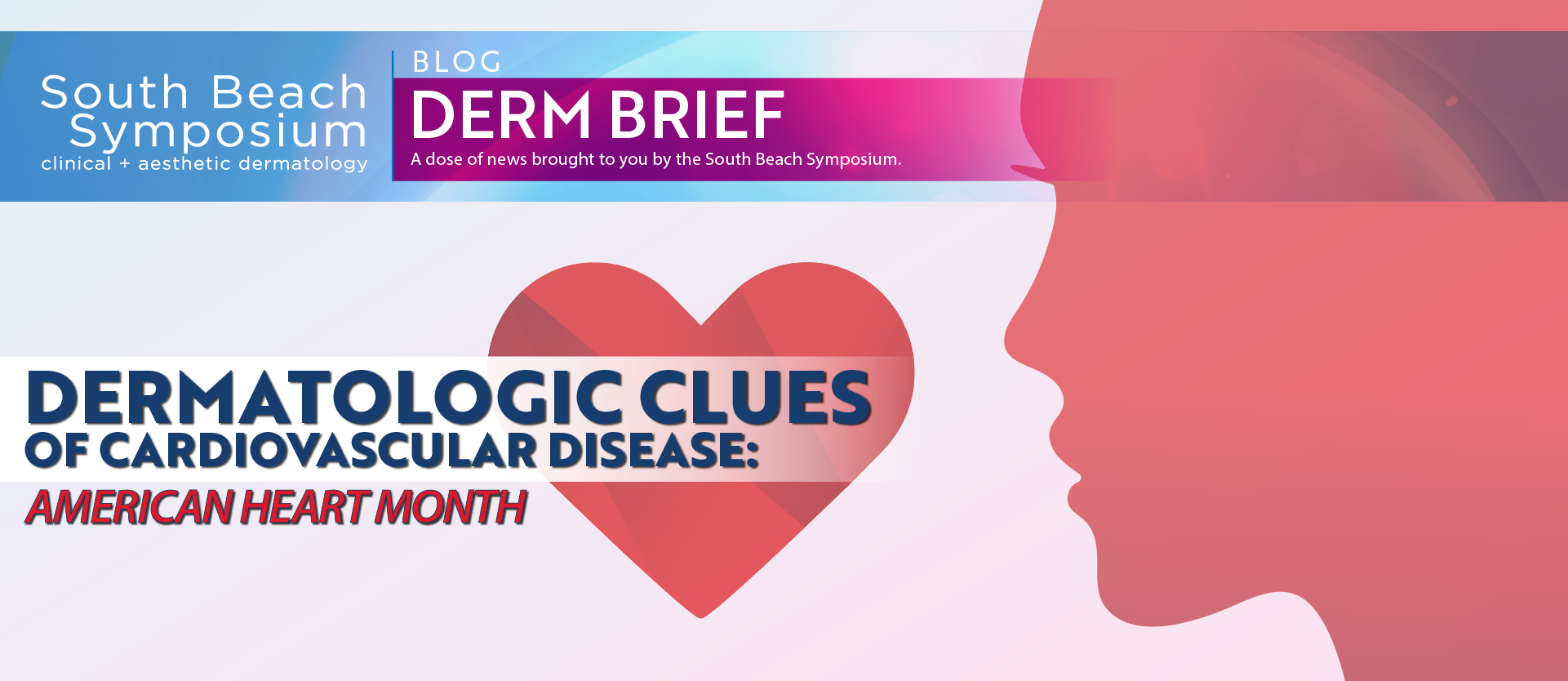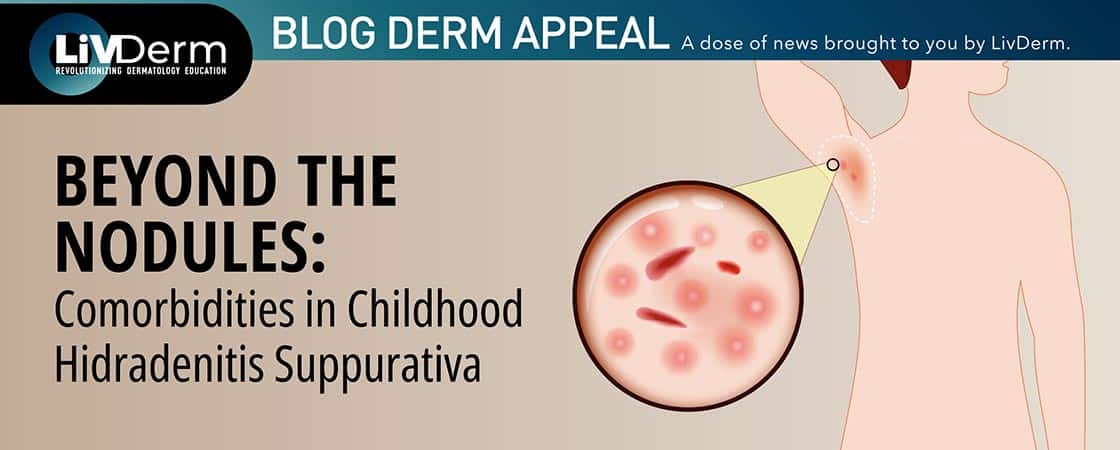In honor of American Heart Month, a national observance that strives to raise awareness among the population about cardiovascular health and disease prevention, we are investigating the intersection of dermatologic and cardiovascular health.
Many dermatologic clues can be indicative of more serious conditions, including cardiovascular diseases. For instance, sarcoidosis can manifest on the skin, resulting in lesions, papules, plaques, and lupus pernio due to its systemic inflammatory properties. Several congenital cardiac defects present unique skin symptoms, such as coarctation of the aorta which is associated with the external features of Turner syndrome. In some cases, dermatologic symptoms represent a part of a systemic or vascular disorder that also involves cardiovascular defects. Cutaneous signals can play a vital role in detecting cardiovascular disease; knowledge of them is important and helpful to ensure the successful treatment of patients.
Some of the more common and clinically relevant dermatologic clues of cardiovascular disease are listed below:
Dermatologic Clues of Cardiovascular Disease
Livedo Reticularis
Livedo reticularis is the most common dermatological signal of a cholesterol embolism, found in 16% of patients. This skin finding consists of mottled, erythematous discoloration of the skin which blanches when pressure is applied. In addition, a painful cyanotic toe can be found in over 25% of cases.
Plaque Sarcoidosis
Plaque sarcoidosis is associated with a multi-system inflammatory disease characterized by non-caseating granulomas occurring in organs and tissue and can be found in up to 25% of sarcoidosis patients. The skin condition is associated with round lesions that are red-brown to purple with a symmetrical distribution that is mostly located on the extremities, face, scalp, back, and buttocks. Plaque sarcoidosis generally has a chronic cutaneous manifestation of under 2 years in length and is associated with more severe systemic involvement. Cardiac involvement in cases of sarcoidosis can occur in up to 30% of patients.
Lupus Pernio
Lupus pernio is a common cutaneous sign also indicative of sarcoidosis, presenting as indolent and disfiguring red to purple nodular or plaque-like lesions found on the cheeks, nose, chin, forehead, or ears. Patients with lupus pernio may have an elevated risk for extracutaneous disease and specifically, pulmonary involvement.
Erythema Nodosum
The most common nonspecific cutaneous manifestation of sarcoidosis is erythema nodosum – a form of skin inflammation resulting in reddish, painful lumps within subcutaneous fat. Erythema nodosum can be found in 20% of patients with sarcoidosis and up to 62% of patients with cutaneous manifestations.
Erythema Marginatum
Occurring in 10% of children alongside their first attack of acute rheumatic fever, erythema marginatum manifests in the form of a flat to mildly elevated, pinkish, nonpruritic, transient eruption found primarily on the trunk and proximal extremities. Erythema marginatum is present in approximately 10% to 25% of patients with acute rheumatic fever.
Xanthelasma Palpebrarum
On average, half of patients who present symptoms of xanthelasma palpebrarum – soft, yellow, cholesterol-filled plaques on the eyelids – have hyperlipidemia. However, the condition alone is not indicative of an increased risk of cardiovascular disease and should be evaluated alongside other detected symptoms.
Xanthomas
Eruptive xanthomas usually appear when serum triglycerides exceed 1500 to 2000 mg/dL. Characterized by crops of 1- to 5-mm, yellow to orange papules with surrounding erythema most commonly located on the extensor surfaces of extremities and the buttocks, this skin condition is strongly associated with hypertriglyceridemia types I, III, IV, and V. These papules usually regress with the correction of elevated lipids, however, cryotherapy may be required if they do not.
Edema
Defined as the clinically apparent increase in the interstitial fluid volume, edema may be localized or generalized, manifesting as puffiness of the face or as skin swelling that retains an indentation when pressed. The most common cause of lower extremity edema is venous insufficiency, however, it may also be caused by congestive heart failure.
Acanthosis Nigricans
Metabolic syndrome is an important risk factor for coronary heart disease, diabetes, and several cancers. One of its dermatologic symptoms may be acanthosis nigricans, or brown, velvety plaques with skin tags indicative of insulin resistance.
Pallor
Pallor, or loss of the normal red or pink hue of the skin and mucous membranes, occurs when hemoglobin levels drop to less than 8-10 g/dL. It may be difficult to identify in patients with congestive heart failure, low skin blood flow, or dark-colored skin and can be most easily identified around vessels that are close to the surface, such as the inner surface of the lower eyelids. Symptoms of pallor found in patients with a prosthetic valve may implicate hemolytic anemia.
Osler Nodes and Janeway Lesions
Both Osler nodes and Janeway lesions develop in patients with infective endocarditis. Osler nodes manifest as small, tender nodules on the finger or toe pads that can persist for hours to days, while Janeway lesions are small hemorrhages that occur on the palms and soles of the feet. Another cutaneous symptom of infective endocarditis is splinter/subungual hemorrhages – or dark-red streaks underneath the nail.
Many other dermatologic symptoms observed in patients may be indicative of serious systemic health conditions, including those with cardiac involvement, and it is important for clinicians to be aware of all of the cutaneous clues. The knowledge of dermatologic manifestations can be tremendously helpful in facilitating early detection and determining accurate diagnoses, ultimately leading to improved health outcomes especially in patients at high risk of cardiovascular disease.

















